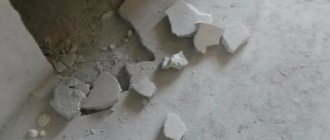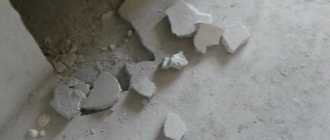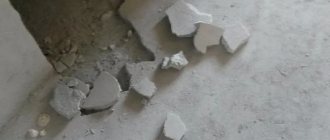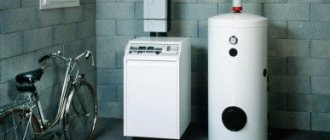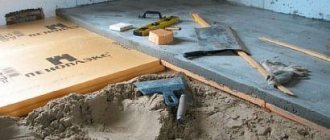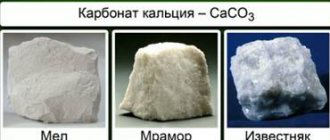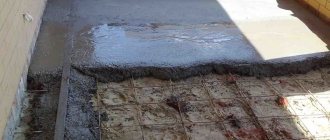Rough finishing is an invisible but very important part of the renovation. The quality of its implementation determines how the final coating will look and how long it will last in its original form. Therefore, before starting finishing work, you need to make sure that the base is strong and reliable, and, if necessary, eliminate defects. If, after leveling, cracks appear in the floor screed, what to do with such a base must be decided on the spot, depending on the scale of the damage, the area of the object, and the type of finished floor covering.
Sometimes it is easier to redo a screed than to repair it Source homemasters.ru
Looking for the cause of the problem
To solve the problem once and for all, you need to find and eliminate the cause of its occurrence, otherwise it will recur. This also applies to situations where the floor screed is cracked - what to do with the cracks can only be decided after you understand why they appeared.
In general, on a surface finished with cement mortar, cracks often form due to the low plasticity of the material and its ability to expand and contract with temperature changes. Their occurrence can be avoided only by strictly following the technology of mixing the solution, preparing the base, installing the screed and fulfilling the conditions necessary for its uniform drying.
The slightest deviation in any of the above points is likely to cause cracking of the cement coating. Most often this happens in the following cases:
- errors when mixing the solution - excess water or uneven distribution of components in the mixture;
Liquid solution has less strength Source strojlyuks.ru
- insufficient screed thickness;
- weak, sagging or vibrating foundation under the screed;
- absence of damper joints or technological gaps between the screed and the walls;
- uneven drying of the solution due to drafts, temperature changes or as a result of forced drying.
The listed factors refer to gross violations of the manufacturing technology of concrete floor screed, which may lead to the impossibility of restoring the coating using spot repairs. If it is covered with deep cracks over the entire area, crumbles underfoot or “breathes,” the screed must be dismantled and remade.
Dismantling a screed is a dirty, time-consuming and expensive job, so it’s better to do everything right right away Source amazonaws.com
If concrete was poured on an unstable sandy base, on a wooden floor or thermal insulation slabs, and the floor screed cracked, what to do: pour another layer on top with mandatory reinforcement with steel mesh.
Defects in a fresh cement coating may not appear immediately, so after finishing the work you need to wait at least 3-4 weeks and then carry out an inspection. To do this, tap the screed with a rubber mallet, revealing local delaminations of the concrete, and strips of thin paper are glued onto the cracks and left for 10-14 days. If after this time it remains intact, it means that the cracks are stable and will not deepen or expand. If the paper is torn, this indicates that the concrete layer is unreliable - it will continue to deteriorate.
Options for dust removal of concrete floors
The formation of fine and medium-fine dust is a problem that sooner or later appears on all concrete floors (if concrete acts as a finishing coating). At the same time, an untreated concrete floor (without topping or impregnation) begins to generate dust almost immediately, regardless of the grade of concrete (however, the lower the grade, the more dust).
Impregnation for concrete
Various impregnations for concrete floors are designed to solve the problem; there are many of them on the market. Compositions can be classified according to the type of action:
- Sealing impregnations. Operating principle – the composition is applied in the form of a varnish to the surface, absorbed to a small depth (up to 1 mm). After application, the composition is clearly visible on the surface of the slab, so its abrasion can be controlled (for re-processing).
- Impregnations acting at the molecular level. The composition is applied to the surface, absorbed and changes the molecular structure of concrete (strengthens). The impregnation is not visible on the surface, does not wear off like a layer of varnish or paint, and lasts longer.
There are also more expensive solutions - applying a thin-layer self-leveling coating (in other words, polymer paint), or installing a self-leveling floor.
Making expansion joints
One of the main reasons for cracking of a concrete slab is the lack of compensation gaps around the perimeter of its abutment to vertical barriers - walls, columns, thresholds, etc. And in rooms with a large area, the screed can crack and swell during shrinkage and during linear expansion, if expansion joints are not installed in it, dividing the solid slab into several sections independent from each other.
The expansion joint allows the screed to expand freely Source tb.ru
See also: Catalog of companies that specialize in home insulation
Before repairing cracks in the floor screed, it is necessary to arrange all the necessary technological joints in it, otherwise they will appear again and again. And the sooner you do this, the better.
It will no longer be possible to create gaps between the floor and the wall using a finished screed. But you can cut the grooves as close to the wall as possible using a grinder with a large diameter disk or a wall chaser. If there are columns, a shrinkage seam is made around them, but not parallel to the edges, but in the form of a diamond, so that the corner of the column looks at the straight section of the groove.
If the dimensions of the room on one or both sides exceed 3-4 meters, the seams must be cut across it.
Note! The depth of the groove must be at least a third of the thickness of the screed, and the width must be at least 10 mm.
The finished cracks in the floor are cleaned of debris and primed. After the primer has dried, they are filled with polyurethane sealant or special mastic. After drying, these compositions retain elasticity, which will allow the cut cards to move independently of each other without transferring deforming loads.
Filling the seam with sealant Source stiagka-pola.ru
Floor condition assessment and initial preparation
The restoration of structures inside and outside the premises precedes the preparatory stage. The site must be fenced, lighting, delivery and preparation of materials and equipment must be organized.
Floor repairs will only be successful if a thorough inspection of the surface is carried out. During this stage, the type and volume of defects, the causes of their occurrence, and what must be eliminated are determined.
The initial assessment of the structure is carried out using visual inspection, for which the following categories are provided:
- good condition of the concrete floor;
- efficient;
- limited capacity;
- emergency (inoperable) condition.
To assess the danger of detected defects, the following categories are used:
- A – defects, damage to critical structures. This poses a danger, even to the point of their destruction. Such floors are taken out of service for repairs, restoration, and strengthening;
- B – defects do not pose a risk of destruction, but over the course of operation they can provoke damage to other components and elements; when they develop, they pass into the first category;
- B – these are local defects and damage. Even when developed, they cannot affect the damage and load-bearing capacity of the main structures.
In order to optimally select the work technology and repair material, a detailed examination of the technical condition of the concrete floor should be carried out. To do this, you should read the technical documentation, inspect the object and conduct instrumental surveys.
As a result, the physical and mechanical characteristics of concrete are assessed (tensile/compressive strength, retention of passivation properties in relation to reinforcement, condition of reinforcement, chloride content). Determine the condition of the artificial stone (moisture content, density, water resistance, etc.). The inspection should be carried out at a positive temperature, from +5 to +10 degrees.
Concrete floors are characterized by several types of damage:
- chips in areas where structures meet;
- reinforcement reaching the surface;
- reinforcement mesh corrosion;
- temperature-shrinkage cracks;
- abrasion and other mechanical damage.
Violation of waterproofing, general structural integrity, and sealing of seams also require repair measures
As a result, several groups of damage can be identified:
- three degrees of reinforcement corrosion (uneven, local, continuous);
- five degrees of concrete damage. The first is characterized by surface contamination (fats, oils, algae, mosses), shrinkage cavities, cracks, but at the same time the surface retains high strength. For the second - a crumbling, dilapidated surface with peeling. There are small chips, shrinkage cracks, and some efflorescence. Strength is reduced by 10-15% of the original. With the third, inactive cracks up to 0.2 mm appear, rust, chips, continuous efflorescence appear, strength is lost by 20%. In the fourth case, inactive and active cracks larger than 0.2 mm appear, there is exposed reinforcement, chips, and severe efflorescence. The fifth degree of destruction is characterized by loose concrete, exposed reinforcement with loosely fixed, exposed filler, deep chips, and internal voids. In some places the material completely loses its strength.
What to do? Damage belonging to the first group does not require immediate action. They can be eliminated during preventative maintenance. If the defects belong to the second group, repairs will provide additional durability of the structure. This must apply to the materials used - they must also be durable. Cracks located in the area where the reinforcement is located must be urgently repaired.
In case of more serious defects, they begin to restore the structure according to a specific feature. The technologies and materials used must ensure the durability and strength of the structure. In some cases, individual projects are developed to repair concrete floors.
If the damage is accompanied by the simultaneous action of the aquatic environment, it is recommended to additionally use penetrating materials as a protective composition when carrying out repair work.
If the surface operates in conditions of variable temperatures, in aggressive conditions, protection of the reinforcement is mandatory, the structure of the artificial stone is compacted, and chemical resistance is increased.
Cracks opened by more than 0.5 mm, voids, are filled by injection. This will increase the load-bearing capacity and restore the solidity of the floor. Repairs are carried out after the development of cracks has ended and the cause of their formation has been determined.
We repair the screed
How to repair cracks in a floor screed depends on the degree of deformation of the subfloor.
Sealing microcracks
Shallow, small cracks usually do not cause problems. They arise due to improper concrete drying conditions. If they begin to appear soon after pouring, the floors should be wetted and covered with film.
Very thin microcracks can be left untouched or covered with liquid cement mortar or tile adhesive. If the width reaches several millimeters, it is better to play it safe and seal such cracks to the full depth.
- The crack is opened by cutting off the concrete on both sides of it with a grinder with a diamond blade, which is set at an angle to the crack.
If the amount of work is small, you can get by with a chisel and a hammer Source wp.com
- Pieces of concrete and cement dust are removed from the resulting triangular furrow.
- Its walls are well impregnated with a deep penetration primer.
- After the primer has dried, fill the recesses with the solution, applying it with a small slide.
- As soon as the solution sets, but does not completely harden, the excess is removed from the surface with a spatula.
If you immediately level the repair mixture over the surface, then during the drying process it will shrink and a depression will form.
Repair compounds for concrete
In order for the restoration of artificial stone to be successful, before choosing a repair composition, a thorough inspection of the destroyed structure is carried out and an analysis is performed. The mixture is selected taking into account the following factors:
- the degree of loading of the structure, its load-bearing capacity;
- depth of damage;
- operating conditions of concrete (humid environment, temperature conditions, degree of exposure to aggressive environments);
- accessibility to the damaged area;
- expected scope of work.
If you are repairing the concrete surface in a visible area, it is important to take into account aesthetic requirements
Major Damage Repair
The large damaged area is filled with new concrete mortar. First, the surface of the structure is cleaned of loose pieces and dust. A clean, solid base of good quality concrete should remain.
Filling is carried out with a cement composition with complex additives that improve its performance characteristics. Good results are achieved by fast-hardening polymer mortar or fiber-reinforced concrete.
For concrete repair with cement mortar to be successful, it is important to create conditions for its reliable adhesion to the base being restored. Two methods are usually practiced:
- Continuous filling of the entire area of the structure is carried out with a solution more than 100 mm thick. If partial restoration is carried out, the concreting site is deepened.
- Better adhesion between old and new layers occurs when a steel reinforced mesh is attached with dowels to the base being restored.
Before pouring the solution, the surface of the structure being repaired is treated with epoxy, acrylic or other adhesive compounds that provide better adhesion.
Dry mixtures for concrete repair
All dry mixes for concrete repair contain cement, which ensures optimal compatibility with the concrete structure being restored. There are many compounds from different companies on the construction market.
Apply the repair composition in a layer 5-50 mm thick on horizontal and vertical substrates. To restore the ceiling, it is optimal to maintain a mixture thickness of 30 mm. Better adhesion is ensured by pre-treatment of concrete with a primer or primer.
concrete repair mixture OSNOVIT
According to the type of application, dry mixtures are divided into the following types:
- for work at temperatures above +5°C;
- at negative temperatures;
- for waterproofing and providing protective properties;
- for repairs that do not change the geometry and load-bearing capacity of the concrete structure.
The scope of application of dry mixtures is wherever quick repairs are required to eliminate defects.
Pros:
- good adhesion to the old base;
- high mechanical strength of the frozen composition;
- due to additives, the mixture does not shrink;
- possibility of eliminating defects up to 100 mm deep.
The disadvantage is the high cost and short shelf life.
Thixotropic mixtures
In essence, these are analogues of conventional dry mixtures, but with improved characteristics. Popular manufacturers are: MAPEI, BASF, Sika. The thixotropic composition for concrete repair is based on cement, sand, and complex additives. Mixtures with polymer fiber are considered the most effective.
Sika concrete repair mixture
The optimal layer thickness is from 10 to 30 mm. The mixture is used when repairing monolithic and prefabricated concrete structures, for sealing seams, and restoring protective layers.
Pros:
- resistance to mechanical loads and abrasion;
- good adhesion to the base;
- resistance of the frozen composition to moisture and low temperatures.
The downside is the high cost and inability to use at sub-zero temperatures.
Epoxy and polymer compounds
The main purpose of the compositions is the repair of self-leveling floors, injection work, and the organization of protection of a concrete structure from the effects of destructive factors. Popular, "Technoplast", "KrasKO".
polymer composition for concrete repair Elakor
Sometimes the composition is applied to improve the adhesion of the base to the new repair layer. Polyurethane mixtures eliminate leaks and prevent the influx of water.
Pros:
- resistance to mechanical and chemical stress;
- good wear resistance;
- high adhesion to the base;
- good waterproofing properties.
The disadvantage is the short viability period.
Video description
How to strengthen concrete that is peeling off from the base is described in the video:
Having found out why the floor screed cracked and what to do, you can begin repairs.
- First, by tapping, areas of delamination and voids are identified and marked with chalk.
- In the marked places, holes are drilled in the screed at a distance of 15-20 cm from each other.
- After cleaning and priming, an epoxy mixture is poured into the holes.
- It also seals cracks.
- After the mixture hardens, the holes are filled with liquid cement mortar.
It is important! This method cannot be used if a water or electric heated floor system is installed in the screed, or other communications without an accurate wiring diagram.
When drilling repair holes, there is a high risk of damaging the cable Source sense-life.com
Which sealant to choose for exterior and interior use
The choice of concrete sealant depends on the following factors:
- Location of damage;
- External or internal method of application;
- At what temperature is the sealant used;
- Will the surface be painted after treatment?
After the buyer has chosen a sealant for joints in concrete, there are important points to remember:
- Volume. The consumption is determined in advance, otherwise the excess will be a waste of money.
- Best before date. There is no benefit from expired sealant; it does not perform its functions.
- The packaging must not have cracks or other damage. If air gets inside, the composition will dry out.
Note! Each concrete joint sealant is designed for a specific location and will only be effective if the instructions are followed.
Sealants are divided into types according to the place and purpose of use. These factors determine its properties and consistency.
- High temperature (heat resistant) sealant for cracks in concrete. Auto mechanics use it. Often used for stoves and fireplaces. Suitable for indoor use, so the room must be thoroughly ventilated. The damage is repaired with a construction gun.
- Water resistant. Suitable for sanitary ware (baths, sinks, showers). Suitable for both indoor and outdoor use.
- Sanitary. Repairing of chips is carried out indoors. Resistant to steam once completely dry.
- Universal. It is used both inside buildings and outdoors. It is used to repair damage to metal, wood, glass and plastic. Withstands both low and high temperatures.
- Outer. Good for sealing cracks in ceramics, concrete and metal. Insensitive to direct sunlight.
- Liquid. Fills cavities in heating systems. Self-sealing. Eliminates leaks in the system.
Is crack repair always necessary?
Even experienced craftsmen cannot always guarantee that the cement screed will retain its solidity and integrity, since, despite its hardness and strength, it is a fragile material that is completely unable to adapt to environmental changes and withstand excessive loads.
In addition, having an impressive weight, the poured concrete slab under the final coating will not go anywhere, even if it cracks. It is not necessary to repair it if:
- the cracks are small and rare, not prone to expansion;
- when tapping with a mallet or walking along the edges of cracks, dust does not rise from them;
- the base does not vibrate under the weight of a walking person;
- Laminate, linoleum or other covering will be laid on the screed without rigid adhesion to it.
But in the case of finishing the floor with ceramic tiles, the diverging edges of the cracks can transfer stress to the tile adhesive and to the tile itself, hopelessly ruining the expensive coating.
A weak screed is the reason for cracking of tiles Source agromat.ua
So that there are no cracks
If you think in advance about how to make a screed so that it does not crack, you can avoid the hassle of repairing it. To do this, several conditions must be met.
- The thickness of the screed at its thinnest point should be at least 20 mm, and if the base is sand, expanded clay or insulation boards - at least 30 mm.
- When installed on a weak or shrinkage-prone base, the screed must be reinforced.
- The screed must be poured over the entire area at once, without taking long breaks.
- If this is not possible, arrange expansion joints at the junction of the dried and fresh mortar.
- Observe the proportions exactly when mixing the solution, taking into account the brand of cement and the moisture content of the sand.
- If, after leveling, puddles of water form on the surface, it means there is too much of it in the solution; it is better to immediately redo this area.
- Avoid drafts during the first days of drying the solution.
- As soon as the screed sets, cover it with film.
- If the air in the room is dry and hot, periodically moisten the surface with water so that the concrete dries evenly.
Stages of repair work when sealing cracks using the trowel/fill method
If defects are found, you should:
- Inspect the entire building structure to identify problems.
- Determine the nature of the defects (surface, through, microscopic, massive), the width of the opening, the degree of exposure of the reinforcing elements.
- Select the repair composition in accordance with the survey data.
- Open up a crack in concrete by removing loose particles with a brush and vacuum cleaner before repairing the defect.
- to clean it from corrosion products with a metal brush and treat it with an anti-corrosion compound.
- Open small cracks to a state in which they can be filled with a repair compound. Large cracks in concrete with an opening width of more than 4 mm - prepare for strengthening. To do this, grooves are made across the gap in the concrete element for laying reinforcing wire in them.
- Treat the surface to be repaired with a primer , which increases the adhesion of the repair composition to the base.
- Seal the cracks . Most often, cement-sand mixtures with factory-prepared expanding cement are used for this purpose. When deciding how to fill a crack in concrete - in the screed and seams between floor slabs - you can choose a mixture consisting of liquid glass (20% of the total mass), cement (20%), sand (60%).
Briefly about the main thing
Cracks in screeds are a frequent and poorly controlled phenomenon. They are formed even with strict adherence to the work technique due to uneven shrinkage of the material, which does not have plasticity. They don't always require repairs. But if the defects occupy a large part of the surface and tend to grow and increase, and the floor “breathes” underfoot, the cracks must be sealed using cement mortar, tile adhesive, sealants or epoxy resin, depending on the situation. It is also advisable to fasten the largest crevices with metal brackets in the transverse cuts.
Climatic and chemical exposure
A separate group consists of defects that arise as a result of a reaction to any chemical substance or climatic influence.
This may include:
- the appearance of light spots and stains, so-called efflorescence, on the surface of the concrete floor. The reason for the formation of salt deposits is a violation of the humidity regime or the ingress of calcium chlorides and alkalis into the composition of the concrete solution. It is for this reason that experts recommend using imported water to prepare the concrete mixture in areas with highly carbonate soils;
- destruction of the concrete floor surface under the influence of low temperatures. When water gets into the pores of the top layer of concrete, it freezes and increases in volume by 10-15%. Therefore, the microscopic pores gradually expand. The more often the freezing/thawing process occurs, the more intensively the concrete deteriorates. To combat this phenomenon, special anti-frost impregnations or compositions are used that reduce the porosity of the material;
- Corrosion of reinforcement also belongs to this group of damages. Metal mortgages become covered with rust where they are exposed. This leads to a decrease in the strength of the reinforcement and the entire concrete structure. To prevent this process, the reinforcement must be treated with an anti-corrosion compound.
All the defects described above can manifest themselves in a variety of forms. The first signs of many of them may look quite harmless, but if they are detected, appropriate measures should be taken. Otherwise, the situation may worsen dramatically over time.
